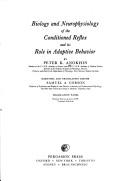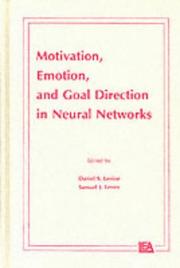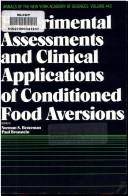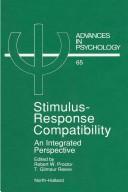| Listing 1 - 5 of 5 |
Sort by
|

ISBN: 0080171605 9780080171609 Year: 1974 Volume: 3 Publisher: Oxford Pergamon
Abstract | Keywords | Export | Availability | Bookmark
 Loading...
Loading...Choose an application
- Reference Manager
- EndNote
- RefWorks (Direct export to RefWorks)
Conditioning, Classical. --- Conditioned response --- -612.8 --- Conditional reflexes --- Conditional response --- Conditioned reflexes --- Response, Conditioned --- Association of ideas --- Behaviorism (Psychology) --- Learning, Psychology of --- Reflexes --- Habituation (Neuropsychology) --- Reflex, Conditioned --- Classical Conditioning --- Classical Conditionings --- Conditioned Reflex --- Conditionings, Classical --- Physiological aspects --- Zenuwstelsel. Zintuigen. Motorische neurowetenschappen --- Conditioning, Classical --- 612.8

ISBN: 0805804471 Year: 1992 Publisher: Hillsdale Erlbaum
Abstract | Keywords | Export | Availability | Bookmark
 Loading...
Loading...Choose an application
- Reference Manager
- EndNote
- RefWorks (Direct export to RefWorks)
Classical conditioning --- Emotions --- Goal (Psychology) --- Motivation (Psychology) --- Neural networks (Neurobiology) --- Conditioning, Classical --- Goals. --- Motivation --- Nerve Net --- Disincentives --- Expectations --- Incentives --- Disincentive --- Expectation --- Incentive --- Motivations --- Drive --- Goal --- Intention --- Regret --- Feelings --- Emotion --- Feeling --- Regrets --- Neural Networks (Anatomic) --- Nerve Nets --- Net, Nerve --- Nets, Nerve --- Network, Neural (Anatomic) --- Networks, Neural (Anatomic) --- Neural Network (Anatomic) --- Pavlovian conditioning --- Conditioned response --- Reflex, Conditioned --- Classical Conditioning --- Classical Conditionings --- Conditioned Reflex --- Conditionings, Classical --- Goal setting --- Setting of goals --- Congresses --- Affective and dynamic functions --- Artificial intelligence. Robotics. Simulation. Graphics --- Goals

ISBN: 0897662806 0897662814 9780897662819 9780897662802 Year: 1985 Volume: 443 Publisher: New York (N.Y.): New York academy of sciences
Abstract | Keywords | Export | Availability | Bookmark
 Loading...
Loading...Choose an application
- Reference Manager
- EndNote
- RefWorks (Direct export to RefWorks)
Affective and dynamic functions --- Physiology of nerves and sense organs --- Conditioned response --- Aversive stimuli --- Avoidance (Psychology) --- Food --- Congresses --- Psychological aspects --- Avoidance Learning. --- Conditioning, Classical. --- Feeding Behavior. --- Food Preferences. --- Taste. --- -Avoidance (Psychology) --- -Conditioned response --- -Food --- -Foods --- Dinners and dining --- Home economics --- Table --- Cooking --- Diet --- Dietaries --- Gastronomy --- Nutrition --- Conditional reflexes --- Conditional response --- Conditioned reflexes --- Response, Conditioned --- Association of ideas --- Behaviorism (Psychology) --- Learning, Psychology of --- Reflexes --- Habituation (Neuropsychology) --- Defense mechanisms (Psychology) --- Stimuli, Aversive --- Aversion therapy --- Punishment (Psychology) --- Gustation --- Taste Sense --- Gustations --- Sense, Taste --- Senses, Taste --- Taste Senses --- Tastes --- Food Selection --- Food Preference --- Food Selections --- Preference, Food --- Preferences, Food --- Selection, Food --- Selections, Food --- Eating Behavior --- Feeding Patterns --- Behavior, Eating --- Behavior, Feeding --- Behaviors, Eating --- Behaviors, Feeding --- Eating Behaviors --- Feeding Behaviors --- Feeding Pattern --- Pattern, Feeding --- Patterns, Feeding --- Nutrition Disorders --- Reflex, Conditioned --- Classical Conditioning --- Classical Conditionings --- Conditioned Reflex --- Conditionings, Classical --- Avoidance Behavior --- Avoidance Behaviors --- Behavior, Avoidance --- Behaviors, Avoidance --- Learning, Avoidance --- -Congresses --- Diet Habits --- Eating Habits --- Dietary Habits --- Food Habits --- Diet Habit --- Dietary Habit --- Eating Habit --- Food Habit --- Habit, Diet --- Habit, Dietary --- Habit, Eating --- Habit, Food --- Habits, Diet --- Habits, Dietary --- Habits, Eating --- Habits, Food --- Avoidance Learning --- Conditioning, Classical --- Feeding Behavior --- Food Preferences --- Taste --- Foods --- Psychological aspects&delete& --- Feeding-Related Behavior --- Behavior, Feeding-Related --- Feeding Related Behavior --- Feeding-Related Behaviors --- Information Avoidance --- Primitive societies --- Aversion Behavior --- Aversion Learning --- Aversive Behavior --- Aversive Learning --- Aversion Behaviors --- Aversive Behaviors --- Behavior, Aversion --- Behavior, Aversive --- Behaviors, Aversion --- Behaviors, Aversive --- Learning, Aversion --- Learning, Aversive --- Conditioned response - Congresses --- Aversive stimuli - Congresses --- Avoidance (Psychology) - Congresses --- Food - Psychological aspects - Congresses
Book
ISBN: 3039212265 3039212257 Year: 2019 Publisher: MDPI - Multidisciplinary Digital Publishing Institute
Abstract | Keywords | Export | Availability | Bookmark
 Loading...
Loading...Choose an application
- Reference Manager
- EndNote
- RefWorks (Direct export to RefWorks)
As CMOS scaling is approaching the fundamental physical limits, a wide range of new nanoelectronic materials and devices have been proposed and explored to extend and/or replace the current electronic devices and circuits so as to maintain progress with respect to speed and integration density. The major limitations, including low carrier mobility, degraded subthreshold slope, and heat dissipation, have become more challenging to address as the size of silicon-based metal oxide semiconductor field effect transistors (MOSFETs) has decreased to nanometers, while device integration density has increased. This book aims to present technical approaches that address the need for new nanoelectronic materials and devices. The focus is on new concepts and knowledge in nanoscience and nanotechnology for applications in logic, memory, sensors, photonics, and renewable energy. This research on nanoelectronic materials and devices will be instructive in finding solutions to address the challenges of current electronics in switching speed, power consumption, and heat dissipation and will be of great interest to academic society and the industry.
quantum mechanical --- n/a --- neuromorphic computation --- off-current (Ioff) --- double-gate tunnel field-effect-transistor --- topological insulator --- back current blocking layer (BCBL) --- CMOS power amplifier IC --- information integration --- distributed Bragg --- spike-timing-dependent plasticity --- electron affinity --- enhancement-mode --- current collapse --- gallium nitride (GaN) --- band-to-band tunneling --- vertical field-effect transistor (VFET) --- ionic liquid --- luminescent centres --- thermal coupling --- vision localization --- PC1D --- UAV --- ZnO/Si --- dual-switching transistor --- memristor --- field-effect transistor --- higher order synchronization --- shallow trench isolation (STI) --- memristive device --- on-current (Ion) --- low voltage --- reflection transmision method --- dielectric layer --- source/drain (S/D) --- high efficiency --- nanostructure synthesis --- InAlN/GaN heterostructure --- supercapacitor --- high-electron mobility transistor (HEMTs) --- heterojunction --- p-GaN --- recessed channel array transistor (RCAT) --- gate field effect --- charge injection --- saddle FinFET (S-FinFET) --- L-shaped tunnel field-effect-transistor --- conductivity --- energy storage --- hierarchical --- PECVD --- sample grating --- MISHEMT --- bistability --- threshold voltage (VTH) --- bandgap tuning --- oscillatory neural networks --- UV irradiation --- Mott transition --- third harmonic tuning --- topological magnetoelectric effect --- cross-gain modulation --- 2D material --- solar cells --- silicon on insulator (SOI) --- Green’s function --- optoelectronic devices --- semiconductor optical amplifier --- ZnO films --- graphene --- AlGaN/GaN --- polarization effect --- two-photon process --- conductive atomic force microscopy (cAFM) --- 2DEG density --- vanadium dioxide --- interface traps --- potential drop width (PDW) --- pattern recognition --- drain-induced barrier lowering (DIBL) --- atomic layer deposition (ALD) --- normally off power devices --- gate-induced drain leakage (GIDL) --- insulator–metal transition (IMT) --- zinc oxide --- synaptic device --- subthreshold slope (SS) --- landing --- silicon --- corner-effect --- conditioned reflex --- quantum dot --- gallium nitride --- bismuth ions --- conduction band offset --- variational form --- Green's function --- insulator-metal transition (IMT)

ISBN: 9780080867199 0080867197 9780444880925 0444880925 1281788651 9786611788650 Year: 1990 Volume: 65 Publisher: Amsterdam ; New York : New York, N.Y., U.S.A. : North-Holland ; Distributors for the U.S. and Canada, Elsevier Pub. Co.,
Abstract | Keywords | Export | Availability | Bookmark
 Loading...
Loading...Choose an application
- Reference Manager
- EndNote
- RefWorks (Direct export to RefWorks)
Stimulus-response compatibility refers to the finding that certain mappings of stimuli to responses produce faster and more accurate responding than do others. The present volume surveys compatibility research which falls into four broad categories: (a) mental representation and coding (b) neurophysiological mechanisms (c) motor performance (d) human factors applications. The major findings and models within each of the categories are summarized, and an integrated perspective is provided. The research indicates that compatibility effects reflect basic cognitive processes that bear on a range o
Conditioned response --- Human engineering --- Conditioning, Classical --- Psychomotor Performance --- Psychophysiology --- 612.8 --- Mind-Body Relationship (Physiology) --- Physiologic Psychology --- Physiological Psychology --- Psychology, Physiologic --- Mind-Body Relations (Physiology) --- Psychology, Physiological --- Mind Body Relations (Physiology) --- Mind Body Relationship (Physiology) --- Mind-Body Relation (Physiology) --- Mind-Body Relationships (Physiology) --- Physiologic Psychologies --- Psychologies, Physiologic --- Relation, Mind-Body (Physiology) --- Relations, Mind-Body (Physiology) --- Relationship, Mind-Body (Physiology) --- Relationships, Mind-Body (Physiology) --- Psychosomatic Medicine --- Mind-Body Relations, Metaphysical --- Perceptual Motor Performance --- Sensory Motor Performance --- Visual Motor Coordination --- Coordination, Visual Motor --- Coordinations, Visual Motor --- Motor Coordination, Visual --- Motor Coordinations, Visual --- Motor Performance, Perceptual --- Motor Performance, Sensory --- Motor Performances, Perceptual --- Motor Performances, Sensory --- Perceptual Motor Performances --- Performance, Perceptual Motor --- Performance, Psychomotor --- Performance, Sensory Motor --- Performances, Perceptual Motor --- Performances, Psychomotor --- Performances, Sensory Motor --- Psychomotor Performances --- Sensory Motor Performances --- Visual Motor Coordinations --- Motor Activity --- Athletic Performance --- Reflex, Conditioned --- Classical Conditioning --- Classical Conditionings --- Conditioned Reflex --- Conditionings, Classical --- Ergonomics --- Human factors in engineering design --- Bioengineering --- Environmental engineering --- Industrial engineering --- Human comfort --- Human-robot interaction --- Conditional reflexes --- Conditional response --- Conditioned reflexes --- Response, Conditioned --- Association of ideas --- Behaviorism (Psychology) --- Learning, Psychology of --- Reflexes --- Habituation (Neuropsychology) --- Zenuwstelsel. Zintuigen. Motorische neurowetenschappen --- Réflexe conditionné --- Ergonomie --- Conditioned response. --- Psychophysiology. --- Human engineering.
| Listing 1 - 5 of 5 |
Sort by
|

 Search
Search Feedback
Feedback About
About Help
Help News
News